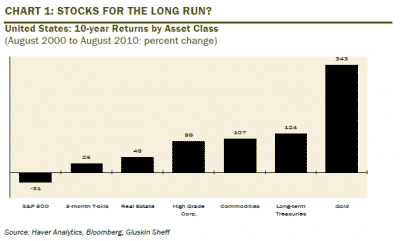Chart of the day: Stocks for the long run?
This chart comes via David Rosenberg at Gluskin Sheff.
Rosenberg tops it off with this commentary:
While we are “underweight” equities as an asset class, we aren’t exactly zero-weight. There are always things to buy and S.I.R.P. does involve a dividend theme, and as such it is encouraging to see company after company, even in the once-growthy tech space, catch on to the insatiable baby boomer appetite for income. Hence, we now see Cisco join the likes of Microsoft and Oracle in generating cash payments to their investors. According to S&P, so far this year, there have been 179 dividend increases and just three cuts — in 2009, there were 110 increases and 72 cuts! The S&P 500 dividend yield is now 2.0% and if you look at the historical data, 45% of the stock market return is derived from reinvested dividends. So, do the math and “expected returns” should really be no higher than 5%. This is exactly what a sub 3% yield on the 10-year T-note is telling you, as well as, a 5% yield on a generic BBB-rated corporate bond. Five percent today is what 10% was two-decades ago and 15% three-decades ago, and if you can achieve that or even do better than that consistently, consider yourself a hero.
Question: is the risk/reward for longer duration government bonds still favourable? If we have a deflationary environment, yields will almost certainly stay low. But, it’s not about if, it’s about risk/reward and this looks less favourable than a year ago.

Reversion to the mean, means that the best classes of the past ten years will probably the worst ones the next ten years.
Jacob, you make a good point! It would seem that bonds and gold would under-perform given that contrarian indicator.
It’s quite the interesting graph. I would like to know how it looked the last few years. The problem with measuring average returns is that it is dominated by noise at the endpoints. I never expected gold to give such high yields but of course I wonder what the return on gold looks like once you account for the storage and security costs.
I suspect a lot of the outperformance for the two leading classes comes from the most recent years, although I don’t have the numbers in front of me. That suggests caution. I am a lot less bullish on bonds or gold than I was a year ago.
can we see a chart for 20, 30 years
I don’t have one but long bonds would be the winner – more than stocks even. Gold would be a relative loser as would commodities.